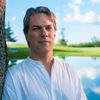
It is Pentecost Sunday and I am sitting in a pew toward the back of a church -- still in the building but not too conspicuous. Foreign tongues are being spoken around me, which seems appropriate since Pentecost is the day celebrated in the Christian Church when, according to the second chapter of Acts, Jesus' followers "were all filled with the Holy Spirit, and began to speak with other languages." This occurred sometime after the ascension of Jesus to Heaven and traditionally marks the start of the spread of the Gospel to foreign lands and cultures. The biblical event signaled a shift from the early followers of Jesus, who were Jewish, to a Gentile-based religion that would become known as Christianity.
But here's the thing about my experience: While I'm in a church building, sitting in a pew with kneelers at my feet, this is no Christian space. I'm in a Vietnamese Buddhist temple in Utica, N.Y., for the celebration of the "Buddha's Birthday" (Vesākha), which this year happens to fall around the same time as Christian Pentecost. As Vietnamese people have fled their homeland due to socio-political turmoil over the past decades, they have settled in cities and towns across the United States, including a small community in Utica.
The temple, dedicated to the female Bodhisattva Quan Am, has been in existence less than a decade when it set up in a former Methodist Church. As the Christians moved on, leaving an empty building, the Vietnamese Buddhists needed a place to gather for prayers, meditation and social events. After some controversy over the size of a statue of Quan Am erected on the front lawn, the temple has been home to monks who reside there, and weekly gatherings of the local community. Striking is the street view of the building with Quan Am standing in front of a giant cross that remains part of the architecture of the building's original purpose.

The interior of the space also gives a hybrid appearance. Most of the pews have been removed, save a few rows toward the back. Placed within alcoves along one wall are small images of a blissful Buddha. Along the other wall are cases with Buddhist books, pamphlets and CDs in Vietnamese. Most of the sanctuary is an open, carpeted space. The main altar is now a grand, multi-colored, multi-sensual structure on which sits a large Buddha statue, with Quan Am and other images filling in the area around. Incense is burned, fruits and flowers stand as offerings, and a small gong awaits its player to signal transitions during the ritual. A series of bright, colorful lights swirl behind the Buddha's head, including a flashing swastika, the ancient symbol of blessing.
On this special day, before the ceremonies begin, a young boy chases another around the floor in the front of the room, while an elderly woman chases the boy, trying to feed him slices of cucumber. Tattooed teenage girls rehearse their part in the ceremony as they offer flowers to the Buddha. Three visiting monks sit calmly toward the front, and two women who seem to be the organizing force behind the whole event coordinate the people involved. I sit in my pew in the back, with a half dozen other Euro-Americans who have been invited to visit. After the service we gather in the downstairs hall for a great potluck dinner of vegetarian Vietnamese food. I sit chewing my wonderfully spiced tofu, cabbage and egg rolls, and imagine a group of Methodists using the same space at the same time on a Sunday for the same purposes, 60 years ago.
Utica is a microcosm of shifting religious attitudes and adherents that are taking place across the United States as mainline Protestant denominations and Jewish synagogues dwindle, the "nones" grow, and new patterns of immigration bring ever-new modes of worship. In downtown Utica, a Bosnian Mosque has been established in a former Methodist Church where the Imam switches from Arabic prayers to sermons in Bosnian and English. Nearby, a Khmer Buddhist temple was recently instituted in which Cambodian immigrants gather for their own style of Buddhist engagement, with their own foods and language. Down the street, the large Tabernacle Baptist Church has been revived in the past decade by an influx of Christian Karen refugees from Burma, and services are held in Karen and English. And a two-century old Roman Catholic parish hosts masses in English, Spanish and Vietnamese.
Religious people in the United States are speaking in tongues in ways seldom imagined before, offering a new twist on the event of Pentecost. As immigration shifts continue to unfold, we will find new ways of being not only "American," but new ways of being religious.
